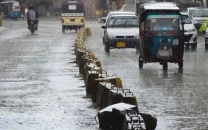Flooding, a new normal
The 2022 floods should have been the wake-up call

Flooding in Pakistan is no longer an occasional crisis. It is a grim and growing reality we must now accept as part of our yearly calendar. With changing climate patterns and unchecked urban expansion, the country is poised to face increasingly severe floods — not once in a decade, but every year. Denial is no longer an option. Preparedness is our only way forward.
The data tells a sobering story. Between 1950 and 2012, the Indus plain endured 19 major flood disasters, resulting in more than 11,000 deaths and economic losses of over $39 billion.
Alarmingly, half of these disasters occurred after 2000. In this monsoon season alone, over 110 lives have been lost due to rain-induced incidents. While we cannot stop the rain, we can stop the destruction, or at least curtail it.
Much of the damage stems not from rainfall alone but from poor human planning — from construction on floodplains to outdated drainage systems and clogged waterways.
Urban sprawl continues to outpace infrastructure development, while rural areas are left to fend for themselves during flash floods and river surges. The most practical and immediate step we can take is to overhaul and upgrade our drainage systems.
Better runoff management can drastically reduce the scale of urban flooding. These are not impossible goals. The 2022 floods should have been the wake-up call. The question now is whether we have learned anything.
Flooding may be the new normal, but loss of life and widespread destruction should not be. What we need to now focus on is disaster preparedness grounded in long-term planning to protect the most vulnerable people and assets. The rain will return next year, and the year after. Whether we face it with resilience or regret is a choice we must make today.















COMMENTS
Comments are moderated and generally will be posted if they are on-topic and not abusive.
For more information, please see our Comments FAQ